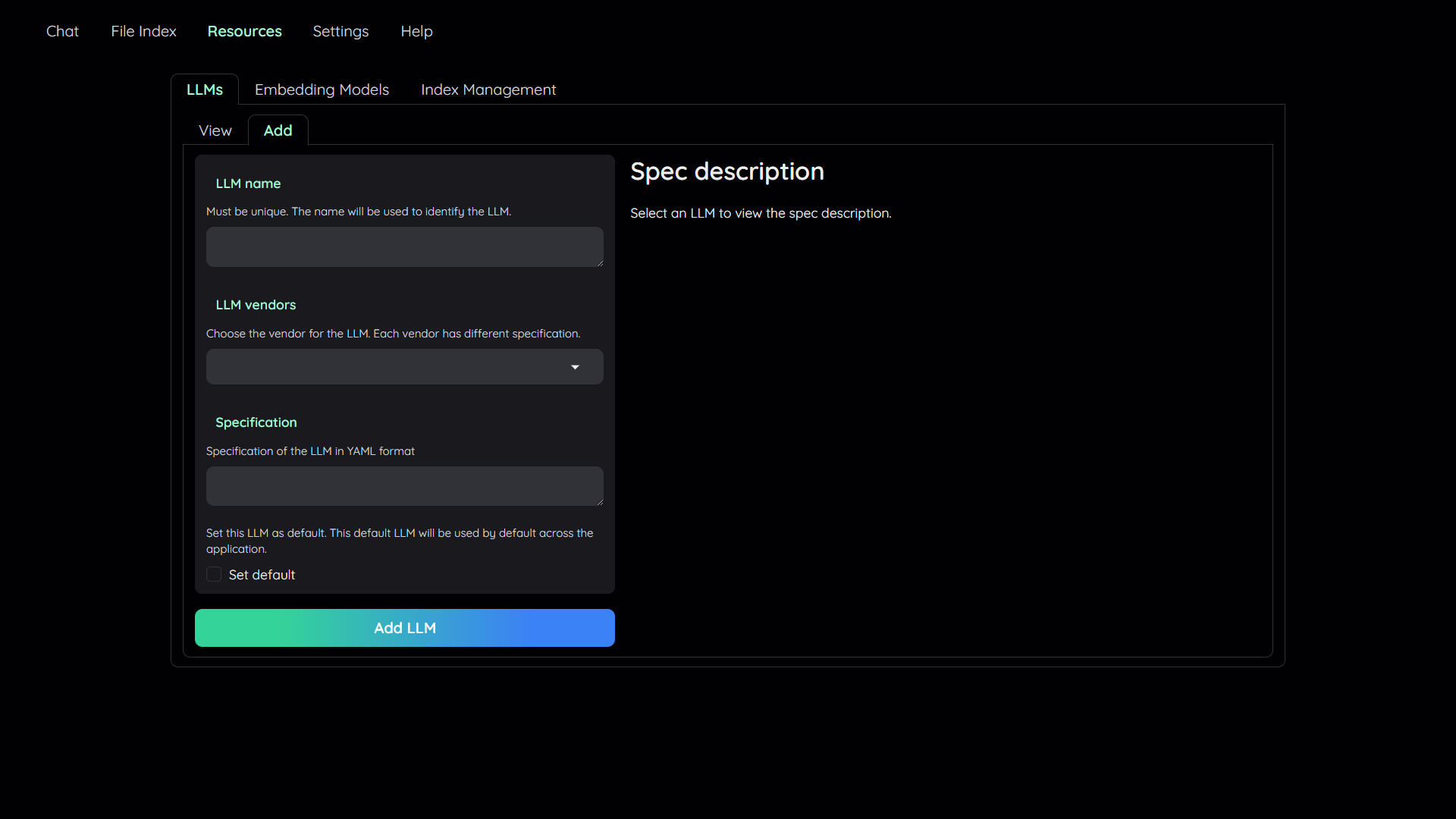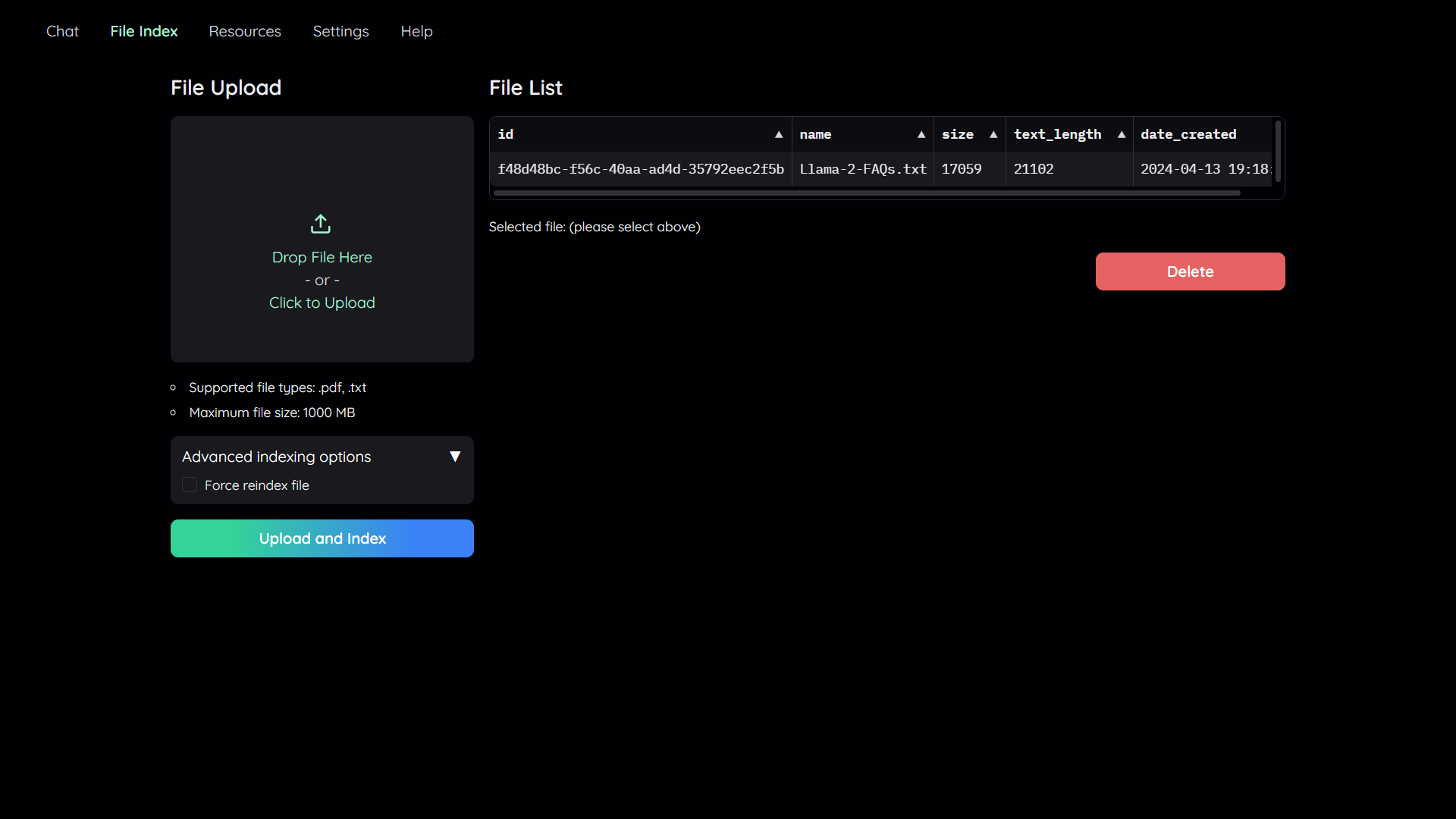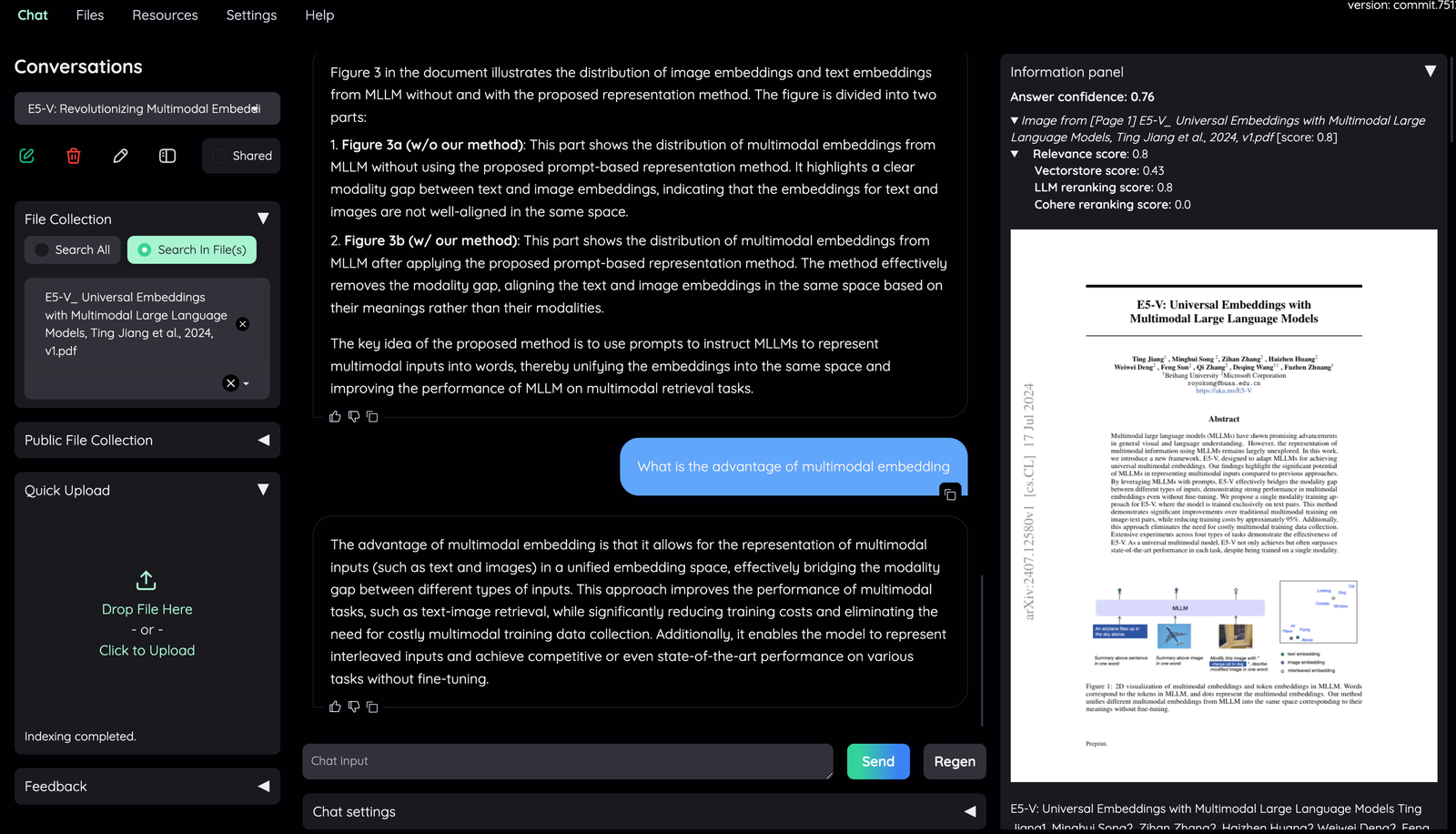mirror of
https://github.com/Cinnamon/kotaemon.git
synced 2025-07-23 08:53:00 +00:00
* docs: update instructions * fix: typo in CONTRIBUTING.md (#614) * fix: typo in usage.md (#598) minor typo fix (tt -> it) --------- Co-authored-by: Varun Sharma <contactvarun27@gmail.com> Co-authored-by: natowi <natowi@users.noreply.github.com>
158 lines
6.5 KiB
Markdown
158 lines
6.5 KiB
Markdown
## 1. Add your AI models
|
|
|
|

|
|
|
|
- The tool uses Large Language Model (LLMs) to perform various tasks in a QA pipeline.
|
|
So, you need to provide the application with access to the LLMs you want
|
|
to use.
|
|
- You only need to provide at least one. However, it is recommended that you include all the LLMs
|
|
that you have access to, you will be able to switch between them while using the
|
|
application.
|
|
|
|
To add a model:
|
|
|
|
1. Navigate to the `Resources` tab.
|
|
2. Select the `LLMs` sub-tab.
|
|
3. Select the `Add` sub-tab.
|
|
4. Config the model to add:
|
|
- Give it a name.
|
|
- Pick a vendor/provider (e.g. `ChatOpenAI`).
|
|
- Provide the specifications.
|
|
- (Optional) Set the model as default.
|
|
5. Click `Add` to add the model.
|
|
6. Select `Embedding Models` sub-tab and repeat the step 3 to 5 to add an embedding model.
|
|
|
|
<details markdown>
|
|
|
|
<summary>(Optional) Configure model via the .env file</summary>
|
|
|
|
Alternatively, you can configure the models via the `.env` file with the information needed to connect to the LLMs. This file is located in
|
|
the folder of the application. If you don't see it, you can create one.
|
|
|
|
Currently, the following providers are supported:
|
|
|
|
### OpenAI
|
|
|
|
In the `.env` file, set the `OPENAI_API_KEY` variable with your OpenAI API key in order
|
|
to enable access to OpenAI's models. There are other variables that can be modified,
|
|
please feel free to edit them to fit your case. Otherwise, the default parameter should
|
|
work for most people.
|
|
|
|
```shell
|
|
OPENAI_API_BASE=https://api.openai.com/v1
|
|
OPENAI_API_KEY=<your OpenAI API key here>
|
|
OPENAI_CHAT_MODEL=gpt-3.5-turbo
|
|
OPENAI_EMBEDDINGS_MODEL=text-embedding-ada-002
|
|
```
|
|
|
|
### Azure OpenAI
|
|
|
|
For OpenAI models via Azure platform, you need to provide your Azure endpoint and API
|
|
key. Your might also need to provide your developments' name for the chat model and the
|
|
embedding model depending on how you set up Azure development.
|
|
|
|
```shell
|
|
AZURE_OPENAI_ENDPOINT=
|
|
AZURE_OPENAI_API_KEY=
|
|
OPENAI_API_VERSION=2024-02-15-preview # could be different for you
|
|
AZURE_OPENAI_CHAT_DEPLOYMENT=gpt-35-turbo # change to your deployment name
|
|
AZURE_OPENAI_EMBEDDINGS_DEPLOYMENT=text-embedding-ada-002 # change to your deployment name
|
|
```
|
|
|
|
### Local models
|
|
|
|
Pros:
|
|
|
|
- Privacy. Your documents will be stored and process locally.
|
|
- Choices. There are a wide range of LLMs in terms of size, domain, language to choose
|
|
from.
|
|
- Cost. It's free.
|
|
|
|
Cons:
|
|
|
|
- Quality. Local models are much smaller and thus have lower generative quality than
|
|
paid APIs.
|
|
- Speed. Local models are deployed using your machine so the processing speed is
|
|
limited by your hardware.
|
|
|
|
#### Find and download a LLM
|
|
|
|
You can search and download a LLM to be ran locally from the [Hugging Face
|
|
Hub](https://huggingface.co/models). Currently, these model formats are supported:
|
|
|
|
- GGUF
|
|
|
|
You should choose a model whose size is less than your device's memory and should leave
|
|
about 2 GB. For example, if you have 16 GB of RAM in total, of which 12 GB is available,
|
|
then you should choose a model that take up at most 10 GB of RAM. Bigger models tend to
|
|
give better generation but also take more processing time.
|
|
|
|
Here are some recommendations and their size in memory:
|
|
|
|
- [Qwen1.5-1.8B-Chat-GGUF](https://huggingface.co/Qwen/Qwen1.5-1.8B-Chat-GGUF/resolve/main/qwen1_5-1_8b-chat-q8_0.gguf?download=true):
|
|
around 2 GB
|
|
|
|
#### Enable local models
|
|
|
|
To add a local model to the model pool, set the `LOCAL_MODEL` variable in the `.env`
|
|
file to the path of the model file.
|
|
|
|
```shell
|
|
LOCAL_MODEL=<full path to your model file>
|
|
```
|
|
|
|
Here is how to get the full path of your model file:
|
|
|
|
- On Windows 11: right click the file and select `Copy as Path`.
|
|
</details>
|
|
|
|
## 2. Upload your documents
|
|
|
|

|
|
|
|
In order to do QA on your documents, you need to upload them to the application first.
|
|
Navigate to the `File Index` tab and you will see 2 sections:
|
|
|
|
1. File upload:
|
|
- Drag and drop your file to the UI or select it from your file system.
|
|
Then click `Upload and Index`.
|
|
- The application will take some time to process the file and show a message once it is done.
|
|
2. File list:
|
|
- This section shows the list of files that have been uploaded to the application and allows users to delete them.
|
|
|
|
## 3. Chat with your documents
|
|
|
|

|
|
|
|
Now navigate back to the `Chat` tab. The chat tab is divided into 3 regions:
|
|
|
|
1. Conversation Settings Panel
|
|
- Here you can select, create, rename, and delete conversations.
|
|
- By default, a new conversation is created automatically if no conversation is selected.
|
|
- Below that you have the file index, where you can choose whether to disable, select all files, or select which files to retrieve references from.
|
|
- If you choose "Disabled", no files will be considered as context during chat.
|
|
- If you choose "Search All", all files will be considered during chat.
|
|
- If you choose "Select", a dropdown will appear for you to select the
|
|
files to be considered during chat. If no files are selected, then no
|
|
files will be considered during chat.
|
|
2. Chat Panel
|
|
- This is where you can chat with the chatbot.
|
|
3. Information Panel
|
|
|
|

|
|
|
|
- Supporting information such as the retrieved evidence and reference will be
|
|
displayed here.
|
|
- Direct citation for the answer produced by the LLM is highlighted.
|
|
- The confidence score of the answer and relevant scores of evidences are displayed to quickly assess the quality of the answer and retrieved content.
|
|
|
|
- Meaning of the score displayed:
|
|
- **Answer confidence**: answer confidence level from the LLM model.
|
|
- **Relevance score**: overall relevant score between evidence and user question.
|
|
- **Vectorstore score**: relevant score from vector embedding similarity calculation (show `full-text search` if retrieved from full-text search DB).
|
|
- **LLM relevant score**: relevant score from LLM model (which judge relevancy between question and evidence using specific prompt).
|
|
- **Reranking score**: relevant score from Cohere [reranking model](https://cohere.com/rerank).
|
|
|
|
Generally, the score quality is `LLM relevant score` > `Reranking score` > `Vectorscore`.
|
|
By default, overall relevance score is taken directly from LLM relevant score. Evidences are sorted based on their overall relevance score and whether they have citation or not.
|